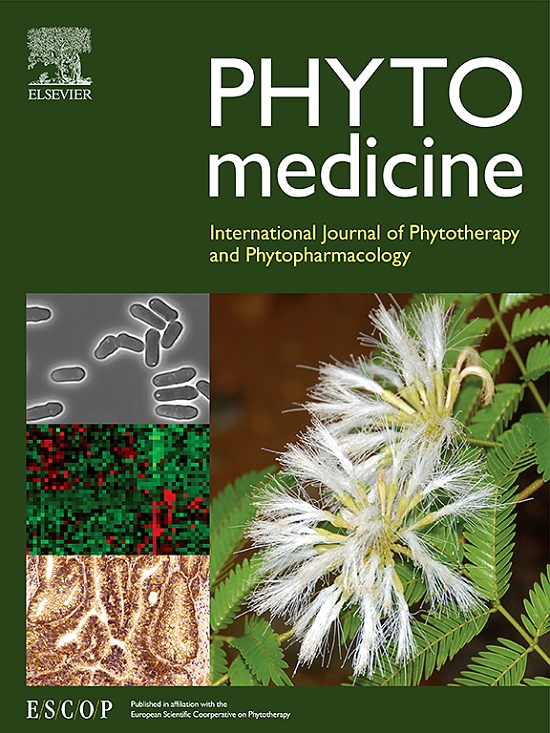Procyanidins inhibit alphacoronavirus infection by reducing interferon antagonism
IF 6.7
1区 医学
Q1 CHEMISTRY, MEDICINAL
引用次数: 0
Abstract
Background
The development of coronavirus drugs has primarily focused on targeting viral components, such as RNA-dependent RNA polymerase (RdRP), with relatively little attention given to enhancing host antiviral defenses. α-Coronaviruses, including human-infecting HCoV-NL63 and HCoV-229E, utilize immune evasion strategies such as suppressing host interferon production to establish infection. Procyanidins (PC), oligomeric compounds composed of catechin and epicatechin, have demonstrated the ability to stimulate host interferon synthesis, potentially counteracting this immune evasion. Exploring the inhibitory effects of PC specifically on α-coronaviruses offers a promising avenue for developing novel therapeutic strategies that bolster host immunity against these pathogens.
Purpose
This study aims to evaluate the inhibitory effects of PC on α-coronaviruses using different cell models and investigate whether its antiviral activity is linked to enhanced interferon production. By examining PC's effects on selected α-coronaviruses, this research explores its potential as a therapeutic strategy against human-infecting HCoV-NL63 and HCoV-229E, which evade innate immunity.
Methods
Vero cells, human embryonic kidney 293T (HEK-293T) cells, and intestinal porcine epithelial-J2 (IPEC-J2) cells were used as cell models, with porcine epidemic diarrhea virus (PEDV) serving as the α-coronavirus infection model. The inhibitory effects of PC on the α-coronaviruses and its activation of interferon were evaluated using quantitative real-time polymerase chain reaction (qRT-PCR) and Western blot (WB). Co-immunoprecipitation (co-IP) was used to assess how PC impacts the degradation of Retinoic acid-inducible gene I (RIG-I) and TANK-binding kinase 1 (TBK1) by coronavirus N protein. Confocal microscopy was utilized to observe the recovery of mitochondrial morphology disrupted by coronavirus, and flow cytometry analyses were conducted.
Results
Viral cycle and time-of-addition analyses showed that PC inhibited PEDV infection during both the replication and release stages of the virus. Simultaneously, in the early stages of infection, PC countered PEDV's evasion of interferon by elevating host interferon levels. Co-immunoprecipitation experiments confirmed that this effect was achieved by reducing the binding of coronavirus N protein to key proteins in the interferon synthesis pathway, RIG-I and TBK1, a mechanism previously identified as one of the main reasons for interferon evasion by α-coronavirus N protein. Additionally, intriguingly, we observed that PC has the ability to restore excessive mitochondrial fission induced by coronaviruses, an effect achieved by reducing the binding of coronavirus N protein to mitochondrial fusion protein 1 (MFN1). This observation suggests potential mechanistic pathways through which PC impacts mitochondrial antiviral-related proteins. These results suggest that PC may also inhibit human α-coronaviruses, such as HCoV-NL63 and HCoV-229E, by utilizing similar antiviral mechanisms. This provides valuable insights into potential therapeutic strategies for treating human coronaviruses.
Conclusions
These results suggest that PC may inhibit α-coronavirus infection by reversing the virus's antagonistic effects on interferon. These findings provide a new perspective for exploring therapeutic mechanisms against coronaviruses like HCoV-NL63, HCoV-229E, SARS-CoV-2, SARS-CoV, and MERS-CoV, which can evade host innate immunity, including the identification of new drug targets.

求助全文
约1分钟内获得全文
求助全文
来源期刊

Phytomedicine
医学-药学
CiteScore
10.30
自引率
5.10%
发文量
670
审稿时长
91 days
期刊介绍:
Phytomedicine is a therapy-oriented journal that publishes innovative studies on the efficacy, safety, quality, and mechanisms of action of specified plant extracts, phytopharmaceuticals, and their isolated constituents. This includes clinical, pharmacological, pharmacokinetic, and toxicological studies of herbal medicinal products, preparations, and purified compounds with defined and consistent quality, ensuring reproducible pharmacological activity. Founded in 1994, Phytomedicine aims to focus and stimulate research in this field and establish internationally accepted scientific standards for pharmacological studies, proof of clinical efficacy, and safety of phytomedicines.
 求助内容:
求助内容: 应助结果提醒方式:
应助结果提醒方式:


